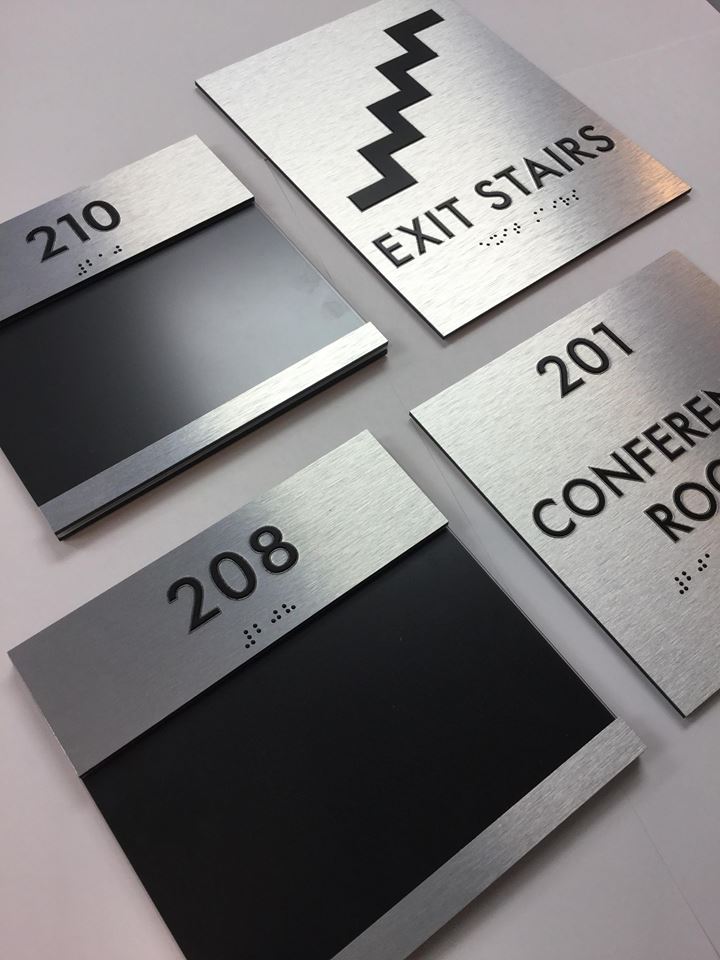Tailoring ADA Signs to Meet Your Details Needs
Tailoring ADA Signs to Meet Your Details Needs
Blog Article
Exploring the Key Features of ADA Indications for Enhanced Ease Of Access
In the realm of access, ADA indications function as quiet yet effective allies, making certain that areas are comprehensive and navigable for individuals with impairments. By integrating Braille and responsive elements, these indications damage obstacles for the aesthetically damaged, while high-contrast color pattern and understandable typefaces deal with varied visual demands. Moreover, their calculated placement is not arbitrary but instead a calculated initiative to promote smooth navigation. Yet, past these features lies a deeper story concerning the advancement of inclusivity and the continuous dedication to developing fair areas. What a lot more could these indications represent in our pursuit of global availability?
Relevance of ADA Conformity
Making sure compliance with the Americans with Disabilities Act (ADA) is important for cultivating inclusivity and equivalent accessibility in public rooms and workplaces. The ADA, enacted in 1990, mandates that all public facilities, companies, and transport solutions fit people with disabilities, ensuring they appreciate the exact same rights and opportunities as others. Compliance with ADA criteria not just fulfills legal commitments yet likewise improves a company's track record by showing its commitment to variety and inclusivity.
One of the essential aspects of ADA compliance is the implementation of accessible signage. ADA indications are made to make sure that individuals with specials needs can conveniently navigate through structures and areas.
Additionally, sticking to ADA guidelines can minimize the risk of prospective fines and lawful consequences. Organizations that stop working to conform with ADA standards might face lawsuits or penalties, which can be both harmful and economically challenging to their public photo. Hence, ADA conformity is important to cultivating a fair atmosphere for everybody.
Braille and Tactile Aspects
The consolidation of Braille and tactile elements into ADA signs embodies the principles of availability and inclusivity. These features are critical for individuals who are blind or visually damaged, allowing them to browse public rooms with better independence and self-confidence. Braille, a tactile writing system, is crucial in giving composed info in a format that can be conveniently regarded through touch. It is normally put beneath the corresponding message on signs to make certain that individuals can access the information without aesthetic assistance.
Responsive aspects extend beyond Braille and consist of increased characters and icons. These elements are developed to be discernible by touch, enabling people to recognize room numbers, restrooms, leaves, and other critical areas. The ADA establishes particular guidelines relating to the dimension, spacing, and positioning of these tactile aspects to enhance readability and ensure consistency throughout different atmospheres.

High-Contrast Color Pattern
High-contrast color plans play a crucial role in boosting the visibility and readability of ADA signage for people with aesthetic problems. These plans are vital as they make best use of the difference in light reflectance between text and background, ensuring that signs are conveniently noticeable, even from a range. The Americans with Disabilities Act (ADA) his explanation mandates using certain color contrasts to suit those with minimal vision, making it an important facet of conformity.
The efficiency of high-contrast colors exists in their capability to stand apart in various lighting conditions, including poorly lit environments and areas with glow. Typically, dark message on a light background or light message on a dark background is employed to accomplish optimal contrast. For example, black text on a white or yellow history gives a raw visual distinction that assists in fast acknowledgment and comprehension.

Legible Fonts and Text Size
When taking into consideration the design of ADA signage, the selection of readable font styles and proper message size can not be overemphasized. These components are critical for guaranteeing that indicators come to individuals with aesthetic impairments. The Americans with Disabilities Act (ADA) mandates that fonts must be sans-serif and not italic, oblique, script, highly decorative, or of unusual kind. These needs assist make sure that the text is easily readable from a range and that the characters are distinct to varied audiences.
The dimension of the text likewise plays a critical duty in accessibility. According to ADA standards, the minimum text elevation ought to be 5/8 inch, and it needs to raise proportionally with checking out distance. This is especially essential in public spaces where signage needs to be read quickly and precisely. Consistency in message dimension adds to a cohesive visual experience, aiding individuals in browsing atmospheres successfully.
Additionally, spacing in between letters and lines is integral to go to this site legibility. Ample spacing avoids characters from appearing crowded, improving readability. By adhering to these requirements, developers can significantly boost access, ensuring that signage serves its desired objective for all people, despite their visual capacities.
Efficient Positioning Strategies
Strategic placement of ADA signs is important for making the most of accessibility and ensuring compliance with legal requirements. Correctly located indicators assist individuals with disabilities successfully, facilitating navigating in public spaces. Key considerations include distance, height, and exposure. ADA guidelines stipulate that signs should be mounted at an elevation between 48 to 60 inches from the ground to guarantee they are within the line of view for both standing and seated individuals. This basic elevation array is vital for inclusivity, enabling wheelchair individuals and individuals of varying elevations to gain access to details effortlessly.
In addition, indicators should be positioned surrounding to the latch side of doors to allow simple recognition prior Learn More to access. This placement assists people locate rooms and spaces without blockage. In cases where there is no door, indicators should be situated on the local surrounding wall. Uniformity in indicator positioning throughout a center improves predictability, decreasing complication and boosting total individual experience.

Verdict
ADA indications play a vital function in advertising access by incorporating features that resolve the requirements of people with disabilities. Incorporating Braille and tactile components makes sure important details comes to the visually damaged, while high-contrast color design and clear sans-serif typefaces boost visibility across numerous illumination conditions. Reliable placement techniques, such as appropriate installing heights and calculated places, further facilitate navigation. These components collectively foster an inclusive environment, emphasizing the importance of ADA conformity in guaranteeing equivalent accessibility for all.
In the world of access, ADA signs offer as quiet yet effective allies, making sure that spaces are comprehensive and accessible for individuals with handicaps. The ADA, established in 1990, mandates that all public facilities, companies, and transportation solutions suit individuals with handicaps, guaranteeing they enjoy the very same rights and possibilities as others. ADA Signs. ADA signs are designed to make sure that individuals with specials needs can easily browse via buildings and areas. ADA standards stipulate that indicators must be mounted at a height between 48 to 60 inches from the ground to ensure they are within the line of view for both standing and seated people.ADA signs play an essential function in promoting access by integrating functions that address the requirements of people with disabilities
Report this page